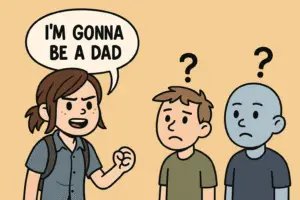1. The Game That Broke Us — In the Best Way
When The Last of Us launched in 2013, it didn’t just raise the bar—it punched a hole in the ceiling of narrative storytelling in games. Players weren’t just moving characters; they were living through Joel and Ellie. A hardened smuggler and a young girl with immunity to the Cordyceps virus, bound not by blood, but by raw, earned love.
What made it iconic?
- Relentless emotional storytelling.
- Realistic, grounded survival mechanics.
- A world that felt like it was already dead—but filled with characters who refused to stop living.
Gamers remember The Last of Us not just for what it let them do, but for what it made them feel.
↻ 2. What It Became: Part II, Divide and Departure
Then came Part II. Ambitious, bold, and unafraid to burn its own legacy.
Joel’s death within the first act shocked even seasoned players. His murder at the hands of Abby, a new character with a vengeful past, rewrote the emotional core of the story. Players were forced—for some, unwillingly—to play as Abby and see the world through her eyes.
Some called it genius. Others called it betrayal.
- Reddit threads erupted.
- Review sites were bombed.
- Neil Druckmann and Naughty Dog became targets in the crossfire.
It wasn’t just about a character dying. It was about ownership of story vs. expectation.
3. Enter HBO: Adaptation or Reinvention?
In 2023, HBO brought The Last of Us to screens worldwide. It stayed faithful where it mattered—and diverted where it didn’t.
What changed:
- Joel’s death was softened, less brutal.
- Bill and Frank’s story became a touching, complete arc.
- Some scenes were reordered for clarity.
- Ellie’s line “I’m gonna be a dad” sparked cultural debate over gender identity, especially since actor Bella Ramsey identifies as non-binary.
For non-gamers, it was gripping. For many gamers, it was hollow. The tension, the dread, the stakes—they felt smaller on-screen.
Showrunners defended the choices, citing broader audience reach and medium differences. But something was lost in translation: the brutality of choice.
4. What Gamers Expected — And What They Got
Gamers expected:
- Gritty violence.
- Emotional dread.
- Familiar arcs.
They got:
- Rearranged plot points.
- Reimagined emotional beats.
- Dialogue and pacing designed for TV, not tension.
And that’s the crux: this was never going to be a 1:1 port. The show wasn’t made for just gamers—it was made for HBO subscribers, casual audiences, even award voters.
That changes the tone. It shifts the emotional target.
⏳ 5. The Last of Us in 2025: What’s Left Standing?
The franchise lives on:
- Season 3 is confirmed.
- The remasters are still selling.
- New players are entering the story for the first time.
But the fanbase?
- Split.
- Worn.
- Watching closely.
Add in DEI controversy, Gamergate 2.0 ripple effects, and new criticism about modern adaptation culture, and The Last of Us stands at the crossroads.
Is it still a game series? Or is it now a brand?
Closing Thoughts
The Last of Us didn’t just tell a story. It built a world so real that its characters lived far beyond the screen. But once that world was opened to adaptation, it became something else—a shared narrative, fractured by perspective.
And maybe that’s okay.
Love it or hate it, The Last of Us didn’t just let us play a story. It made us feel one. And for better or worse, we still do.

